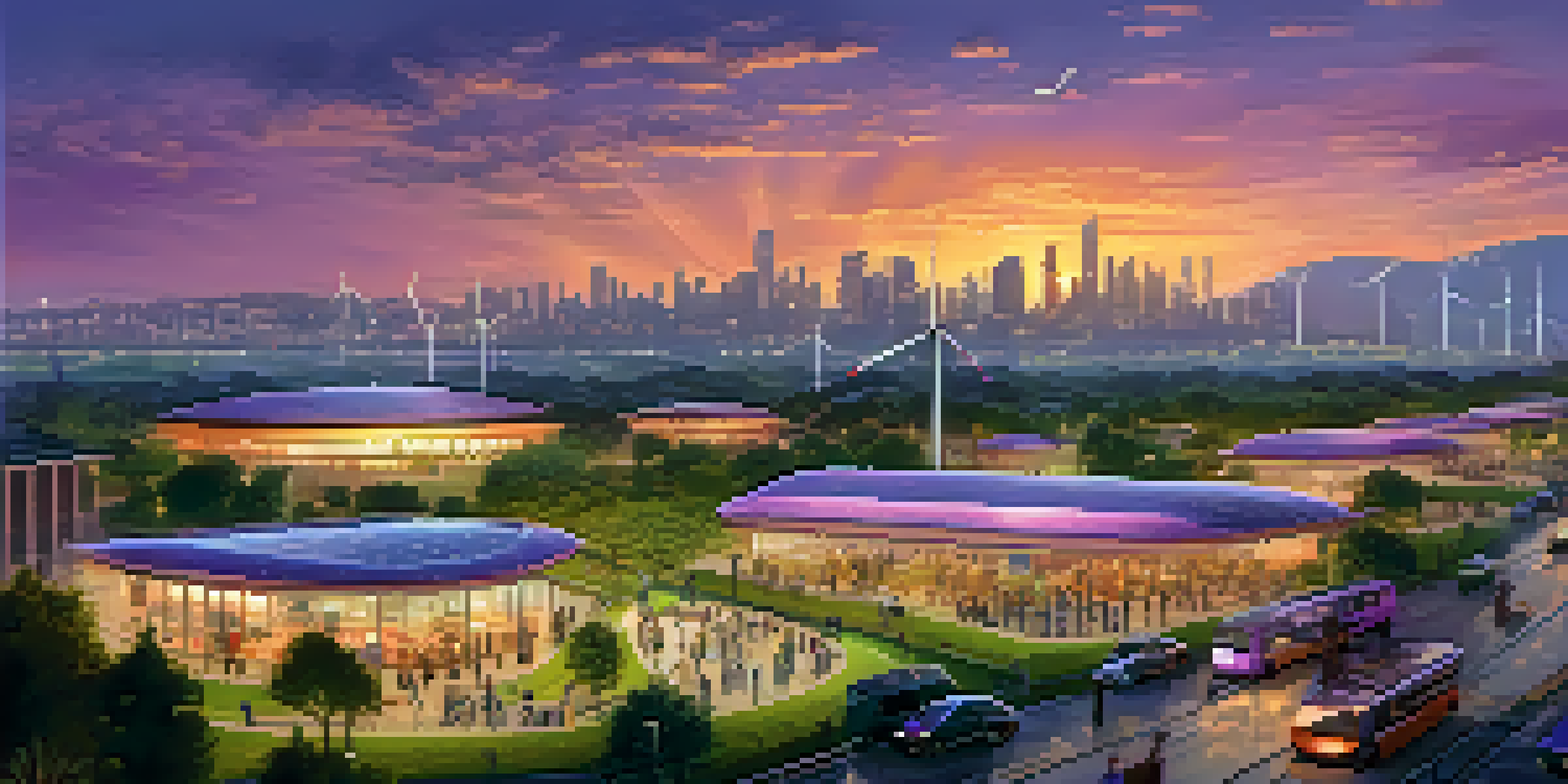The Intersection of Smart Cities and Climate Change

Understanding Smart Cities and Their Importance
Smart cities utilize technology and data to enhance urban living. By integrating IoT devices, they streamline services such as transportation, energy use, and waste management. This approach not only improves efficiency but also helps cities become more sustainable, a crucial aspect in the fight against climate change.
The city is not a concrete jungle, it is a human zoo.
As urban populations grow, the need for smarter infrastructure becomes more urgent. With more people living in cities, the demand for resources increases, leading to higher emissions and environmental impact. Smart cities aim to address these challenges through innovative solutions that prioritize sustainability.
Ultimately, smart cities represent a holistic approach to urban development. They leverage technology to create a more connected, efficient, and eco-friendly environment, making them a critical player in combating climate change.
The Role of Technology in Smart Cities
Technology serves as the backbone of smart cities, enabling better resource management. For instance, smart sensors can monitor air quality, traffic patterns, and energy consumption in real-time. This data allows city planners to make informed decisions that reduce the urban carbon footprint.

Moreover, technologies like renewable energy sources and smart grids play an essential role in reducing emissions. By optimizing energy distribution and integrating solar or wind power, cities can decrease their reliance on fossil fuels, significantly contributing to climate change mitigation.
Smart Cities Enhance Urban Living
By leveraging technology and data, smart cities improve resource management and sustainability, addressing the challenges of urbanization.
In addition to energy management, technology helps improve public services. Apps that provide real-time information on public transportation encourage people to opt for greener commuting options, further reducing congestion and pollution in urban areas.
Green Infrastructure and Urban Design
Green infrastructure is vital in the context of smart cities, focusing on nature-based solutions. Incorporating parks, green roofs, and urban forests not only beautifies the city but also helps mitigate heat, manage stormwater, and improve air quality. These features contribute to the city's overall resilience against climate change.
Sustainability is no longer about doing less harm. It's about doing more good.
Urban design plays a crucial role in promoting sustainable living. By creating walkable neighborhoods and mixed-use developments, cities can reduce dependency on cars. This shift not only lowers greenhouse gas emissions but also fosters a sense of community among residents.
The integration of green spaces within urban settings enhances biodiversity, which is essential for a resilient ecosystem. By prioritizing nature in city planning, we can create environments that thrive amidst the challenges posed by climate change.
Data-Driven Decision Making for Sustainability
Data analytics is a powerful tool in the smart city landscape. By collecting and analyzing data from various sources, city officials can identify trends and make evidence-based decisions to enhance sustainability. This data-driven approach allows for more effective resource allocation and policy implementation.
For example, cities can analyze traffic data to optimize public transport routes, reducing congestion and emissions. Predictive analytics can also help forecast energy demand, allowing for more efficient energy management and reducing waste.
Community Engagement is Key
Involving residents in smart city initiatives fosters trust and leads to more effective and inclusive sustainability solutions.
Involving citizens in the data collection process further enhances the effectiveness of these initiatives. When residents participate in monitoring and reporting, they become active stakeholders in the city's sustainability efforts, fostering a sense of ownership and accountability.
Community Engagement in Smart City Initiatives
Community involvement is essential in shaping smart city projects. Engaging residents in the planning process ensures that initiatives reflect their needs and priorities. This collaborative approach not only builds trust but also leads to more successful outcomes in sustainability efforts.
Through workshops, surveys, and public forums, cities can gather input on proposed projects. This feedback loop encourages residents to voice their concerns and suggestions, leading to better, more inclusive solutions. In this way, the community becomes an integral part of the urban transformation.
Moreover, educational programs about sustainability can empower residents with the knowledge to make informed decisions. When citizens understand the impact of their actions, they are more likely to adopt eco-friendly practices, further supporting the city's climate goals.
Policy and Governance for Climate Action
Effective governance is crucial for the success of smart city initiatives. Policymakers must create frameworks that encourage innovation while ensuring environmental sustainability. This involves setting regulations that promote green technology and incentivize sustainable practices among businesses and residents.
Additionally, collaboration between government agencies, private sectors, and communities is vital. By working together, these stakeholders can pool resources and knowledge, leading to comprehensive strategies that address climate change effectively.
Data-Driven Decisions for Sustainability
Utilizing data analytics enables city planners to make informed choices that enhance sustainability and effectively allocate resources.
Ultimately, strong leadership and commitment to sustainability will drive the success of smart cities. Policymakers must prioritize climate action, viewing it as a core component of urban development rather than an afterthought.
The Future of Smart Cities and Climate Resilience
As we look to the future, the concept of smart cities continues to evolve. Innovations in technology, data analytics, and community engagement will shape how cities respond to climate change. The integration of these elements will not only enhance urban living but also improve our capacity to adapt to environmental challenges.
Emerging technologies like artificial intelligence and machine learning hold the potential to revolutionize urban management. These advancements can provide deeper insights into patterns and behaviors, allowing cities to anticipate and respond to climate-related issues proactively.

In the end, the journey toward smart, sustainable cities is a collective effort. By embracing innovation and fostering collaboration, we can create urban environments that are resilient to climate change, ensuring a better quality of life for future generations.